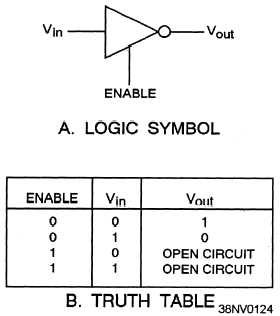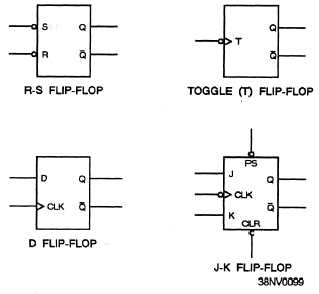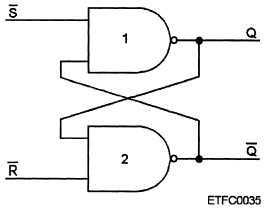Another variation of the three basic functions is the
tristate logic gate. It has three states: the standard 0
and 1 and a third state, which disengages the gate from
the system. In tristate logic, the third state is an open
circuit. A tristate device allows the connection of the
outputs of devices in parallel without affecting circuit
operation. An example of a tristate inverter and its truth
table is provided in figure 4-9. When the enable signal
corresponds to logic 0, the circuit operates as a normal
inverter; if Vin is a logic 0, Vout is a logic 1, and vice
versa. If, however, the circuit is enabled (enabled = 1),
the output is an open circuit regardless of the states of
the input signal.
Flip-Flops
Flip-flops are sequential logic elements. Their
operation is influenced by their previous condition, or
by the sequential application of clock pulses that set the
timing of all computers. More about timing later in this
topic. Flip-flops are also called bistable multivibrators.
The output of a flip-flop (0 or 1) remains the same until
a specific input signal changes its output state.
Flip-flops are used to store data temporarily, perform
mathematical operations, count operations, or to
receive and transfer data. They have only two distinct
outputs and can have up to five different inputs
depending on the type of flip-flop. They can represent
one bit or more than one bit. Refer to figure 4-10 for an
example of a basic flip-flop.
Figure 4-9.—Example of a tristate inverter: A. Logic symbol;
B. Truth table.
Figure 4-10.—Example of a basic flip-flop.
FLIP-FLOP CHARACTERISTICS AND
TYPES. —Flip-flops share one characteristic that is
consistent with the various types of flip-flops. They
have two, and only two, distinct output states. Some
basic terms used with flip-flops for the output labels and
input labels as follows:
The output labels are and
and always
complementary to each other. When = 1, then
= 0; and vice versa.
The input labels are R= reset; S = set; T= toggle;
CLK = clock; PS = preset; CLR = clear; and J,
K, or D = data.
The four types of flip-flops (fig. 4-11) are as
follows:
R-S (Reset-Set) flip-flop —Temporarily holds or
stores information until it is needed
Figure 4-11.—Examples of types of flip-flops.
4-10





